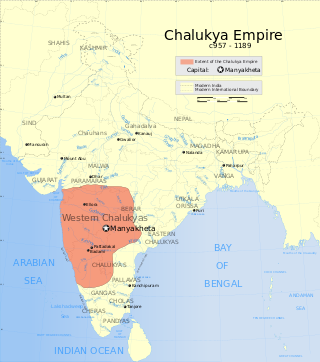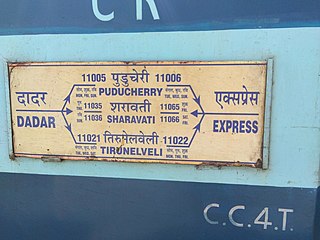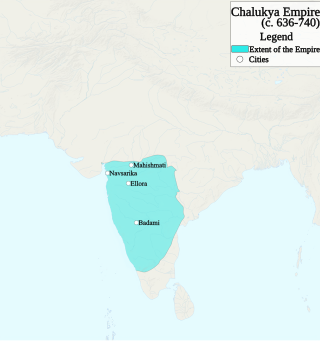
The middle kingdoms of India were the political entities in the Indian subcontinent from 230 BCE to 1206 CE. The period begins after the decline of the Maurya Empire and the corresponding rise of the Satavahana dynasty, starting with Simuka, from 230 BCE. The "middle" period lasted for almost 1436 years and ended in 1206 CE, with the rise of the Delhi Sultanate, founded in 1206, and the end of the Later Cholas.
Pulakeshi II popularly known as Immaḍi Pulakeśi, was the greatest Chalukyan Emperor who reigned from Vatapi. During his reign, the Chalukya empire expanded to cover most of the Deccan region in peninsular India.

Lakkundi, also referred to as Lokkugundi, was a major city before the 14th century, and is now a village in Gadag District of Karnataka, India. By 10th century, it was already a major economic and commerce center with mint operations for South India, one mentioned in Kannada and Sanskrit inscriptions and texts. By 12th century, many Hindu and Jain temples had been consecrated here, along with public infrastructure such as stepwells and water reservoirs. Among the major temples are the Brahma Jinalaya (oldest), Mallikarjuna, Lakshminarayana, Manikeshwara, Naganatha, Kumbheshvara, Nanneshwara, Someshwara, Narayana, Nilakanteshwara, Kasivisesvara, Virabhadhara, Virupaksha, and others. As its importance and wealth grew, Lakkundi became one of the capitals of the Hoysala Empire.
Kirttivarman I was a ruler of the Chalukya dynasty of Vatapi in India. He ruled parts of present-day Karnataka, Goa, Maharashtra and Andhra Pradesh.
Pulakeshin was the first sovereign ruler of the Chalukya dynasty of Vatapi. He ruled parts of the present-day Maharashtra and Karnataka states in the western Deccan region of India. Pulakeshin established the city of Vatapi, and performed the Ashvamedha sacrifice to assert his sovereign status. The dynasty established by him went on to rule a major part of peninsular India in the subsequent years.
Mangalesha was a king of the Chalukya dynasty of Vatapi in Karnataka, India. He succeeded his brother Kirttivarman I on the throne, and ruled a kingdom that stretched from southern Gujarat in north to Bellary-Kurnool region in the south, in the western part of the Deccan region. It included parts of present-day Gujarat, Maharashtra, Goa, Karnataka, and Andhra Pradesh.

North Karnataka is a geographical region in Deccan plateau from 300 to 730 metres elevation that constitutes the region of the Karnataka state in India and the region consists of 13 districts. It is drained by the Krishna River and its tributaries the Bhima, Ghataprabha, Malaprabha, and Tungabhadra. North Karnataka lies within the Deccan thorn scrub forests ecoregion, which extends north into eastern Maharashtra.

The Western Chalukya Empire ruled most of the western Deccan, South India, between the 10th and 12th centuries. This Kannada-speaking dynasty is sometimes called the Kalyani Chalukya after its regal capital at Kalyani, today's Basavakalyan in the modern Bidar district of Karnataka state, and alternatively the Later Chalukya from its theoretical relationship to the 6th-century Chalukya dynasty of Badami. The dynasty is called Western Chalukyas to differentiate from the contemporaneous Eastern Chalukyas of Vengi, a separate dynasty. Before the rise of these Chalukyas, the Rashtrakuta Empire of Manyakheta controlled most of the Deccan Plateau and Central India for over two centuries. In 973, seeing confusion in the Rashtrakuta empire after a successful invasion of their capital by the ruler of the Paramara dynasty of Malwa, Tailapa II, a feudatory of the Rashtrakuta dynasty ruling from Bijapur region defeated his overlords and made Manyakheta his capital. The dynasty quickly rose to power and grew into an empire under Someshvara I who moved the capital to Kalyani.

The Kalachuris of Kalyani, also Southern Kalachuris, were a 10th-12th-century Indian dynasty, who ruled over parts of present-day northern Karnataka and Maharashtra. This dynasty will rise to its peak power in the Deccan region between 1156 and 1181.

The 11021 / 11022 Dadar–Tirunelveli Chalukya Express is an express train of the Indian Railways connecting Tirunelveli Junction in Tamil Nadu and Dadar of Mumbai, Maharashtra. It is currently being operated as 11021/11022 train numbers on tri-weekly basis.

The Chalukya dynasty was a Classical Indian dynasty that ruled large parts of southern and central India between the 6th and the 12th centuries. During this period, they ruled as three related yet individual dynasties. The earliest dynasty, known as the "Badami Chalukyas", ruled from Vatapi from the middle of the 6th century. The Badami Chalukyas began to assert their independence at the decline of the Kadamba kingdom of Banavasi and rapidly rose to prominence during the reign of Pulakeshin II. After the death of Pulakeshin II, the Eastern Chalukyas became an independent kingdom in the eastern Deccan. They ruled from Vengi until about the 11th century. In the western Deccan, the rise of the Rashtrakutas in the middle of the 8th century eclipsed the Chalukyas of Badami before being revived by their descendants, the Western Chalukyas, in the late 10th century. These Western Chalukyas ruled from Kalyani until the end of the 12th century.

The Chaulukya dynasty, also Solanki dynasty, was a dynasty that ruled the Kingdom of Gujarat in western India, between c. 940 CE and c. 1244 CE. Their capital was located at Anahilavada. At times, their rule extended to the Malwa region in present-day Madhya Pradesh. The family is also known as the "Solanki dynasty" in the vernacular literature. They belonged to the Solanki clan of Rajputs.
Chamundaraja was an Indian king who ruled parts of present-day Gujarat from his capital at Anahilapataka. He was a member of the Chaulukya dynasty.
Durlabha-raja was an Indian king who ruled parts of present-day Gujarat from his capital at Anahilapataka. He was a member of the Chaulukya dynasty.

The Kalachuris of Mahismati, or the Early Kalachuris, were an early medieval Indian dynasty that ruled present-day Maharashtra, as well as parts of mainland Gujarat and southern Madhya Pradesh. Their capital was located at Mahishmati. Epigraphic and numismatic evidence suggests that the earliest of the Ellora and Elephanta cave monuments were built during the Kalachuri rule.

The 11005 / 11006 Dadar–Puducherry Chalukya Express is an express train of the Indian Railways connecting Puducherry in Puducherry and Dadar of Mumbai, Maharashtra. It is currently being operated with 11005 / 11006 train numbers on daily basis.

The 11017 / 11018 Dadar–Yesvantpur Chalukya Express was an express train of the Indian Railways connected Yesvantpur Junction in Karnataka and Dadar of Mumbai, Maharashtra. It was operated as 11017/11018 train numbers on six days a week.
The Chalukyasof Navasarika were an Indian dynasty that ruled parts of present-day Gujarat and Maharashtra during 7th and 8th centuries, as vassals of the Chalukyas of Vatapi. They are also known as the "Early Chalukyas of Gujarat".
Jayasimha was the first ruler of the Chalukya dynasty of Vatapi in present-day India. He ruled the area around modern Bijapur in the early 6th century, and was the grandfather of the dynasty's first sovereign ruler, Pulakeshin I.
Ranaraga was an early 6th century ruler of the Chalukya dynasty of Vatapi in present-day India. A vassal ruler, he was the father of the dynasty's first sovereign ruler, Pulakeshin I.









